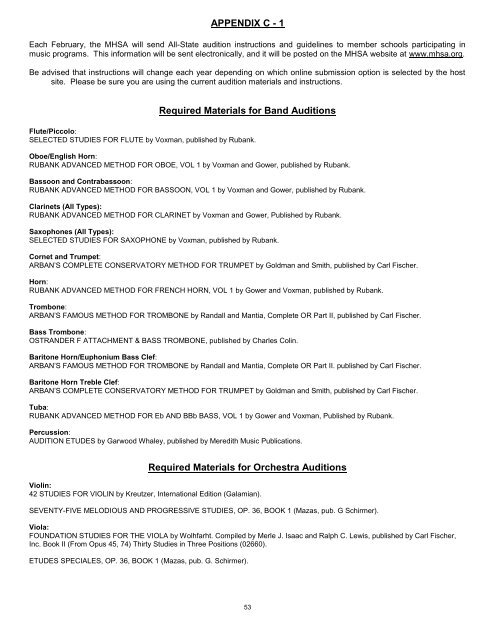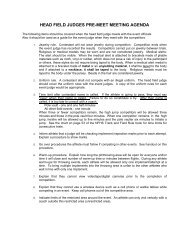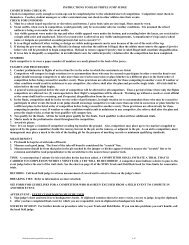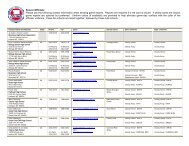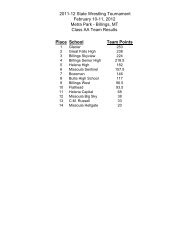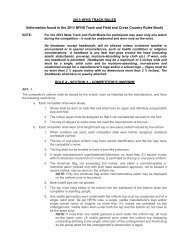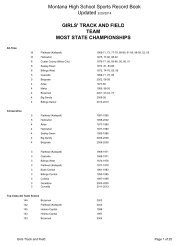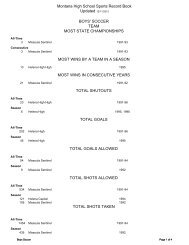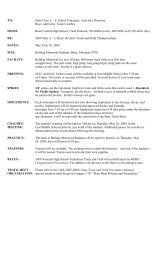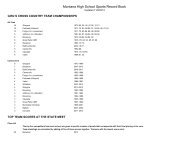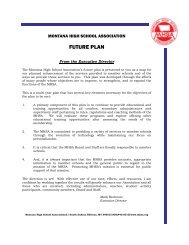APPENDIX C - 1 Required Materials for Band Auditions Required ...
APPENDIX C - 1 Required Materials for Band Auditions Required ...
APPENDIX C - 1 Required Materials for Band Auditions Required ...
Create successful ePaper yourself
Turn your PDF publications into a flip-book with our unique Google optimized e-Paper software.
OBOE AND ENGLISH HORNChromatic Scale: Low Bb ( Bb below middle C to F3 (b on English Horn). Use legato-tongued quarter notes at m.m. = 132ascending and descending. Oboists who wish to be considered <strong>for</strong> English Horn parts should include an example of theirEnglish Horn playing.Rubank Advanced Method <strong>for</strong> Oboe, Vol. 1Page 16 - #62 (D Major) Quarter Note: m.m. = 92-104Page 23 - #5 (a Minor) Quarter Note: m.m. = 80Page 49 = #15 (G Major) Quarter Note: m.m. = 88BASSOONChromatic Scale: Contra BBb (BBb below bass clef) to Bb1 (3rd line treble clef). Use legato-tongued quarter notes at m.m. =132 ascending and descending.Julius Weissenborn: 50 Studies, OP. 8: No. 2. Published by Carl FischerPage 4, #3 - (no repeats) Quarter Note: m.m. = 112Page 12, #16 - First 8 measures Quarter Note: m.m. = 92Page 22, #28 - First 12 measures Dotted Quarter Note: m.m. = 84Bb CLARINETChromatic Scale: Low E (E below middle C) to G3. Use legato-tongued quarter notes atm.m. = 132 ascending and descending.Rubank Advanced Method <strong>for</strong> Clarinet Vol. 1 by Voxman/GowerPage 28-29, #9 measure 14 to end. (Top Part) Half Note: m.m. = 60Page 42 (1 st 12 measures) Quarter Note: m.m. = 60Page 50 - #4 Half Note: m.m. = 88Page 53 - #13 Quarter Note: m.m. = 100ALTO AND BASS CLARINETChromatic Scale: Low E (E below middle C) to C3. Use legato-tongued quarter notes atm.m. = 132 ascending and descending.Rubank Advanced Method <strong>for</strong> Clarinet Book 1Page 13 - #47 Quarter Note: m.m. = 112Page 51 - #8 Dotted Quarter: m.m. = 100Page 25 (bottom part) Dotted half: m.m. = 60CONTRA CLARINETS (USE TUBA MATERIALS)SAXOPHONEIf interested in playing Soprano Saxophone, please include both a saxophone (alto, tenor) of your choice and SopranoSaxophone playing the Soprano last. State at the beginning of the recording that you are auditioning <strong>for</strong> both. Include a SopranoSaxophone excerpt of your choice at the end of the exercises listed below:Chromatic Scale: Low Bb (Bb below middle C) to F3. Use legato-tongued quarter notes at m.m. = 132 ascending anddescending.Selected Studies <strong>for</strong> Saxophones by Voxman & Gower. Published by RubankPage 9 - First 12 measures Quarter Note: m.m. = 104Page 41 - First 16 measures Quarter Note: m.m. = 84Page 15 - First 16 measures Dotted Quarter Note: m.m. = 76TRUMPETChromatic Scale: Low F# (F# below middle C) to C3. Use legato-tongued quarter notes at m.m. = 132 ascending anddescending.Arban's Complete Conservatory Method <strong>for</strong> Trumpet. Published by Carl Fisher.Page 30 - #25 Quarter Note: m.m. = 120Page 144 - #50, line 12 Quarter Note: m.m. = 92Page 145 - #51, line 1 Quarter Note: m.m. = 84Page 149 - #55, lines 3 & 12 Quarter Note: m.m. = 92Page 195 - #19As MarkedFRENCH HORNChromatic Scale: C (1 octave below middle C) to C3 or as high as possible. Use legato-tongued quarter notes at m.m. = 132ascending and descending.Rubank Advanced Method Vol. 1. Gower/Voxman.Page 25 - #7, bottom part - no repeats Quarter Note: m.m. = 90Page 51 - #14 Dotted Quarter Note: m.m. = 90Page 72 - First 6 linesAs marked55
TROMBONEChromatic Scale: G (bottom line bass clef) to G1. Use legato-tongued quarter notes at m.m. = 132 ascending and descending.Arban's Complete Method <strong>for</strong> Trombone and Baritone. Published by Carl Fischer.Page 66 - #18 Quarter Note: m.m. = 92Page 156 - Line 2 and 9 Quarter Note: m.m. = 88Page 244, Theme Quarter Note: m.m. = 80Page 245 - Variation 1BASS TROMBONEAll applicants must have an F attachment or Bass Trombone and be able to play down toLow C.Chromatic Scale: Low E (E below bass clef) to E1. Use legato-tongued quarter notes atm.m. = 132 ascending and descending.Arban's Complete Method <strong>for</strong> Trombone. Published by Carl Fischer.Page 66 - #18 Quarter Note: m.m. = 76Page 156 - Line 2 Quarter Note: m.m. = 72Ostrander F Attachment & Bass Trombone. Published by Charles Colin.Page 23 - #59, Etude Quarter Note: m.m. = 100EUPHONIUM AND BARITONE BASS CLEFChromatic Scale: Low G (bottom line bass clef) Bb1. Use legato-tongued quarter notes atm.m. = 132 ascending and descending.Arban's Complete Method <strong>for</strong> Trombone and Baritone. Published by Carl Fischer.Page 143 - #29 Quarter Note: m.m. = 100Page 153 - #50 lines 4, 8 Quarter Note: m.m. = 92Page 158 - #55 lines 1, 3 Quarter Note: m.m. = 76Page 108 - #42 Eighth Note: m.m. = 112BARITONE TREBLE CLEFChromatic Scale: Low A (A below middle C) to C3. Use legato-tongued quarter notes atm.m. = 132 ascending and descending.Arban's Complete Conservatory Method <strong>for</strong> Trumpet by Goldman Smith. Published by Carl Fischer.Page 137 - #29 Quarter Note: m.m. = 100Page 144 - #50, lines 4, 8 Quarter Note: m.m. = 92Page 149 - #55, lines 1, 3 Quarter Note: m.m. = 76Page 106 - #42 Eighth Note: m.m. = 112TUBA (AND CONTRA CLARINETS)Chromatic Scale: BBb (below bass clef) to Bb (top of bass clef). Use legato-tongued quarter notes at m.m. = 132 ascendingand descending.Rubank Advanced Method <strong>for</strong> E and BB Tuba, Vol. 1.Page 27 - #3, lines 1, 2, 3, plusone measure and one note Quarter Note: m.m. = 108Page 39 - #25, lines 1, 2, 3 Dotted Quarter Note: m.m. = 84Page 47 - #7, All - No repeats, stop at D.C. Dotted Quarter Note: m.m. = 116Page 64 - #7 Quarter Note: m.m. = 92PERCUSSIONStudents with sufficient background should attempt to submit one recording playing all or some of the percussion excerpts. Anef<strong>for</strong>t will be made to select versatile musicians in the percussion section. Additional time may be allotted.SNARE DRUM:Orchestral (Multiple bounce)rollplay PPppRudimental (double stroke)rollslow-fastAudition Etudes by Garwood Whaley <strong>for</strong> Snare Drum, Timpani, Keyboard Percussion, and Multiple Percussion.Page 9 - #9 Eighth Note: m.m. = 144TIMPANI:Roll on low Gplay ppppRoll on high Dplay ppppF Major Scale using 2 Timpani - legato stroke Quarter Note: m.m. = 80ascending and descendingAudition Etudes by Garwood Whaley <strong>for</strong> Snare Drum, Timpani, Keyboard Percussion and Multiple Percussion. Meredith MusicPublications.Page 14 - #6 Dotted Quarter Note: m.m. = 11656
KEYBOARD: Eb Major Scale played2 Octaves ascending and descendingAudition Etude by Garwood Whaley <strong>for</strong> Snare Drum, Timpani, Keyboard Percussion, and Multiple Percussion. Meredith MusicPublications.Page 19 - #2 Quarter Note: m.m. = 80MULTIPLE PERCUSSION:Audition Etudes by Garwood Whaley <strong>for</strong> Snare Drum, Timpani, Keyboard Percussion and Multiple Percussion. Meredith MusicPublications.Page 28 - #3 Quarter Note: m.m. = 100MONTANA ALL-STATE CHORUS AUDITION MATERIALSET AALL EXERCISES ARE TO BE SUNG A CAPPELLA. THE PITCH SHOULD BE GIVEN ONLY ONCE BEFORE EACHEXERCISE. The pitch must be sounded on the recording so that a standard pitch reference is available to the screeningcommittee. This will eliminate difficulty created by variable piano intonation.1. Sing two scales, ascending and descending using do-re-mi-fa-so-la-ti-do without restating top note. Quarter notem.m. = 72. Each scale recorded as a separate track.Soprano I: D and A Tenor I: Eb and G(Above Mid C & 3 rd Space) Tenor II: C and FSoprano II: C and G Bass I: Ab and Eb (3rd space(Mid C and 2 nd Line) Bass Clef)Alto I: A (below middle C) Bass II: F (1st space below Bass Clefand F (first space)and D (3rd line)Alto II: G (below middle C)and Eb (1st line)2. Sing Chromatic Scale ascending and descending (The pitch should be given only once – repeat top note).Use solfege syllables or one of the basic vowel sounds: AH-A-EE-O-OO (A consonant may be used to begin the vowel).Soprano I: E to E Tenor I: E to ESoprano II: D to D Tenor II: D to DAlto I: C to C Bass I: C to CAlto II: Bb to Bb Bass II: Bb to Bb3. Sing the melody and words to the 1st verse of "MY BONNIE" (Check the key and give the starting pitch only once):Soprano I: My Bonnie. Key of DSoprano II: My Bonnie. Key of CAlto I: My Bonnie. Key of AAlto II: My Bonnie. Key of GTenor I: My Bonnie. Key of DTenor II: My Bonnie. Key of CBass I: My Bonnie. Key of ABass II: My Bonnie. Key of G4. Soprano I, II or Alto I, IISing Alto part while piano plays Soprano, Tenor, and Bass to one of the following selections:"DRINK TO ME WITH THINE EYES ONLY" Key of EbTenor I, II:Sing your part while piano plays Soprano, Alto, Bass to:"DRINK TO ME WITH THINE EYES ONLY" Key of EbBass I, II:Sing your part while piano plays Soprano, Alto, Tenor to:"DRINK TO ME WITH THINE EYES ONLY" Key of EbDEVIATION FROM ABOVE EXERCISES WILL AUTOMATICALLY ELIMINATE APPLICANT.Source: The New Blue Book of Favorite Songs, Schmitt, Hall & McCreary.Permission to copy these parts has been received from the publisher, and a master is enclosed.57
MONTANA ALL-STATE ORCHESTRA AUDITION MATERIALSET AHARP:1. Identify and play a one-minute excerpt illustrating glissando effects.2. Identify and play a one-minute excerpt illustrating chord effects.3. Identify and play a one-minute excerpt illustrating harmonics.VIOLIN: 42 Studies <strong>for</strong> Violin by Kreutzer, International Edition (Galamian).1. A Major Scale (Three octaves, eighth notes, slur 4 notes to a bow, no vibrato, quarter note = 72)2. b Melodic Minor (Three octaves, detaché, quarter notes with vibrato, quarter note = 72)3. C Major Scale (One octave, four sixteenth notes per pitch, spiccato, quarter note = 84 - 92)4. Kreutzer, Study # 5 (detaché, quarter note = 72)5. Identify and play a two-minute excerpt from your solo literature.VIOLA: Foundation Studies <strong>for</strong> the Viola by Wolhfarht. Compiled by Merle J. Isaac and Ralph C. Lewis, published by Carl Fischer, Inc.Book II (From Opus 45, 74) Thirty Studies in Three Positions (02660).1. C Major Scale (Three octaves, eighth notes, slur 4 notes to a bow, no vibrato, quarter note = 72)2. c Melodic Minor (Three octaves, detaché, quarter notes with vibrato, quarter note = 72)3. F Major Scale (One octave, four sixteenth notes per pitch, spiccato, quarter note = 84 - 92)4. Wolhfarht, Bk. II, # 50, P. 21 (quarter note = 66)5. Identify and play a one-minute excerpt from your solo literature.CELLO: 170 Foundation Studies <strong>for</strong> the Violoncello by Alwin Schroeder, published by Carl Fischer, Inc. Volume I (02469).1. D Major scale (Three octaves, eighth notes, slur 4 notes to a bow, no vibrato, quarter note = 72)d Melodic Minor Scale (Three octaves, detaché, quarter notes with vibrato, quarter note = 72)F Major Scale (One octave, four sixteenth notes per pitch, spiccato, quarter note = 84 - 92)4. Schroeder, Vol. 1, # 75, p. 90, (Andante introduction, quarter note = 48)5. Identify and play a one-minute excerpt from your solo literature.BASS: Nuovo Metodo Per Contrabasso (New Method <strong>for</strong> Double Bass) by Isaia Bille, published by G.Ricordi, Milan, Italy. Bille 261 =Part I. Practical Course I, E. R. 2611. Bb Major Scale (Two octaves, eighth notes, slur 2 notes to a bow, no vibrato, quarter note = 72)2. g Melodic Minor Scale (Two octaves, detaché, quarter notes with vibrato, quarter note = 72)3. Bille 261, # 78, p. 54 (quarter note = 96)Bille 261, # 119, p. 79 (quarter note = 92)Identify and play a one-minute excerpt from your solo literature.Revised: Gilstrap 2000<strong>APPENDIX</strong> C - 4MONTANA ALL-STATE BAND AUDITION MATERIALSET BSTUDENTS FROM SCHOOLS OF ALL SIZES SHOULD BE ENCOURAGED SUBMIT AUDITION RECORDINGS FOR THE MONTANAALL-STATE BAND AND ORCHESTRA. ADMITTEDLY, SOME WILL NOT BE ABLE TO PLAY THE REQUIRED RANGES ON THECHROMATIC SCALES OR TEMPO INDICATIONS ON EXCERPTS. IN THESE CASES STUDENTS ARE ASKED TO PLAY AS HIGHAS POSSIBLE OR AS CLOSE TO THE METRONOME MARKING AS POSSIBLE.FLUTE AND PICCOLOIf interested in playing piccolo, please include both flute and piccolo playing, flute first. State at beginning of recording that youare auditioning on both. Please include a piccolo excerpt of your choice at the end of the exercises listed below:Chromatic Scale: Middle C to C4. Use legato-tongued quarter notes atm.m. = 132 ascending and descending.Selected Studies <strong>for</strong> Flute by H. Voxman. Published by Rubank.Page 6 to first ending Quarter Note: m.m. = 132Page 50 - First 7 lines plus two measures Dotted Quarter Note: m.m. = 66Page 31 - First 3 lines plus one measure + 1 noteAdagio Cantabile59
OBOE AND ENGLISH HORNChromatic Scale: Low Bb (Bb below middle C) to F3 (B on English Horn). Use legato-tongued quarter notes at m.m. = 132ascending and descending. Oboist who wish to be considered <strong>for</strong> English Horn parts should include an example of theirEnglish Horn playing.Rubank Advanced Method <strong>for</strong> Oboe, Vol. 1Page 50 - #18 (e Minor) Quarter Note: m.m. = 96-100Page 50-51 - #20 (Bb Major)(TakeSecond Ending) Dotted Quarter Note: m.m. = 92Page 67 - #3 (F Major) Quarter Note: m.m. = 72-80BASSOONChromatic Scale: Contra BBb (BBb below bass clef) to Bb1 (3rd line treble clef). Use legato-tongued quarter notes at m.m. =132 ascending and descending.Julius Weissenborn: 50 Studies, OP. 8: Book II. Published by Carl FischerPage 3, #2 - (no repeats) Dotted Quarter Note = 63Page 18, #22 - First 8 measures only(stop at fermata) Dotted Quarter Note: m.m. = 88Page 21, #27 - First 16 measures only Quarter Note: m.m. = 72Bb CLARINETChromatic Scale: Low E (E below middle C) to G3. Use legato-tongued quarter notes at m.m. = 132 ascending anddescending.Rubank Advanced Method <strong>for</strong> Clarinet Vol. 1 by Voxman/GowerPage 27 (Top Line), No repeats Dotted half m.m. = 60Page 47 - #24 (Top Line) Quarter Note: m.m. = 72Page 49 - Last 21 measuresHalf Note: m.m. = 88 (cut time)Page 55 - #19 Quarter Note: m.m. = 100ALTO AND BASS CLARINETChromatic Scale: Low E (E below middle C) to C3. Use legato-tongued quarter notes at m.m. = 132 ascending and descending.Rubank Advanced Method <strong>for</strong> Clarinet Book 1Page 10 - #31 Quarter Note: m.m. = 112Page 50 - #5, Play to the end, no repeats Dotted Quarter Note: m.m. = 112Page 25 - #7 bottom part, no repeats Quarter Note: m.m. = 120CONTRA CLARINETS (USE TUBA MATERIALS)SAXOPHONEIf interested in playing soprano saxophone, please include both a saxophone (alto, tenor) of your choice and soprano saxophoneplaying the soprano last. State at the beginning of the recording that you are auditioning <strong>for</strong> both. Include a soprano saxophoneexcerpt of your choice at the end of the exercises listed below:Chromatic Scale: Low Bb (Bb below middle C) to F3. Use legato-tongued quarter notes at m.m. = 132 ascending anddescending.Selected Studies <strong>for</strong> Saxophones by Voxman & Gower. Published by RubankPage 13 - First 16 measures Quarter Note: m.m. = 112Page 32 - First 16 measures Eighth Note: m.m. = 100Page 38 - Last 8 measures Dotted Quarter Note: m.m. = 60TRUMPETChromatic Scale: Low F# (F# below middle C) to C3. Use legato-tongued quarter notes at m.m. = 132 ascending anddescending.Arban's Complete Conservatory Method <strong>for</strong> Trumpet. Published by Carl Fischer.Page 30 - #24 Quarter Note: m.m. = 120Page 144 - #50, line 4 Quarter Note: m.m. = 92Page 145 - #51, line 8 Quarter Note: m.m. = 84Page 149 - #55, lines 2 & 10 Quarter Note: m.m. = 92Page 192 - #6No required m.m.FRENCH HORNChromatic Scale: C (1 octave below middle C) to C3 or as high as possible. Use legato-tongued quarter notes at m.m. = 132ascending and descending.Rubank Advanced Method Vol. 1. Gower/Voxman.Page 25 - #7, bottom part - no repeats Quarter Note: m.m. = 90Page 50 - #10 Quarter Note: m.m. = 120Page 72 - First 6 linesAs marked60
TROMBONEChromatic Scale: G (bottom line bass clef) to G1. Use legato-tongued quarter notes atm.m. = 132 ascending and descending.Arban's Complete Method <strong>for</strong> Trombone and Baritone. Published by Carl Fischer.Page 63 - #3 Quarter Note: m.m. = 92Page 156 - Line 1 and 8 Dotted Quarter Note: m.m. = 88Pages 236 - ThemeAs markedPage 236 - Variation 1 (cont. on 237) Quarter Note: m.m. = 80BASS TROMBONEAll applicants must have an F attachment or bass trombone and be able to play down to Low C.Chromatic Scale: Low E (E below bass clef) to E1. Use legato-tongued quarter notes atm.m. = 132 ascending and descending.Arban's Complete Method <strong>for</strong> Trombone. Published by Carl Fischer.Page 63 - #3 Quarter Note: m.m. = 76Page 156 - line 1 Dotted Quarter Note: m.m. = 72Ostrander F Attachment and Bass Trombone. Published by Charles Colin.Page 21 - #54, Etude Quarter Note: m.m. = 100EUPHONIUM AND BARITONE BASS CLEFChromatic Scale: Low G (bottom line bass clef) Bb1 . Use legato-tongued quarter notes at m.m. = 132 ascending anddescending.Arban's Complete Method <strong>for</strong> Trombone and Baritone. Published by Carl Fischer.Page 66 - #18 Quarter Note: m.m. = 108Page 153 - #50 lines 12, 13 Quarter Note: m.m. = 92Page 158 - #55 lines 1, 11 Quarter Note: m.m. = 76Page 106 = #36 Eighth Note: m.m. = 108BARITONE TREBLE CLEFChromatic Scale: Low A (A below middle C) to C3. Use legato-tongued quarter notes at m.m. = 132 ascending anddescending.Arban's Complete Conservatory Method <strong>for</strong> Trumpet by Goldman Smith.Published by Carl Fischer.Page 62 - #18 Quarter Note: m.m. = 100Page 144 - #50, lines 12, 13 Quarter Note: m.m. = 92Page 149 - #55, lines 1, 11 Quarter Note: m.m. = 76Page 104 - #36 Eighth Note: m.m. = 108TUBA (AND CONTRA CLARINETS)Chromatic Scale: BBb (below bass clef) to Bb (top of bass clef). Use legato-tongued quarter notes at m.m. = 132 ascending anddescending.Rubank Advanced Method <strong>for</strong> E and BB Tuba, Vol. 1.Page 32 - #12, lines 1, 2, 3 plus 1 note Quarter Note: m.m. = 120Page 35 - #18, lines 1, 2, 3, 4 - Stop at Fine Dotted Quarter Note: m.m. = 120Page 37 - #21 last 11 measures with pickup;lower octave last line Quarter Note: m.m. = 104Page 38 - #23 Dotted Quarter Note m.m. = 60PERCUSSIONStudents with sufficient background should attempt to submit one recording playing all or some of the percussion excerpts. Anef<strong>for</strong>t will be made to select versatile musicians in the percussion section. Additional time may be allotted.SNARE DRUM:Orchestral (multiple bounce) roll: play pp < ff > ppRudimental (double stroke) roll:play slow-fastAudition Etudes by Garwood Whaley <strong>for</strong> Snare Drum, Timpani, Keyboard Percussion and Multiple Percussion. Meredith MusicPublications.Page 7 - #6 Quarter Note: m.m. = 108TIMPANI:Roll on low G play pp ppRoll on high Dplay pp ppF Major Scale using 2 timpani -legato strokeascending and descending Quarter Note: m.m. = 80Audition Etudes by Garwood Whaley <strong>for</strong> Snare Drum, Timpani, Keyboard Percussion and Multiple Percussion. Meredith MusicPublications.Page 13 - #3Quarter Note: m.m. = 10461
KEYBOARD: F Major Scale played2 octaves ascending and descendingAudition Etude by Garwood Whaley <strong>for</strong> Snare Drum, Timpani, Keyboard Percussion, and Multiple Percussion. Meredith MusicPublications.Page 21 - #5Quarter Note: m.m. = 92MULTIPLE PERCUSSION:Audition Etude by Garwood Whaley <strong>for</strong> Snare Drum, Timpani, Keyboard Percussion, and Multiple Percussion. Meredith MusicPublications.Page 27 - #2Quarter Note: m.m. = 112MONTANA ALL-STATE CHORUS AUDITION MATERIALSET BALL EXERCISES ARE TO BE SUNG A CAPPELLA. THE PITCH SHOULD BE GIVEN ONLY ONCE BEFORE EACHEXERCISE. The pitch must be sounded on the recording so that a standard pitch reference is available to the screeningcommittee. This will eliminate difficulty created by variable piano intonation.1. Sing two scales, ascending and descending, using do-re-mi-fa-so-la-ti-do without restating top note. Quarter note m.m. = 72.Each scale recorded as separate track.Soprano I: D and A (2nd space) Tenor I: Eb and GSoprano II: C and G (2nd line) Tenor II: C and FAlto I: A (below middle C) Bass I: Ab and Eb (3rd space)and F (first space)Bass ClefAlto II: G (below middle C) Bass II: F (1 space below Bass Clef)and Eb (1st line)and D (3rd line)2. Sing Chromatic Scale ascending and descending. (The pitch should be given only once). Repeat top note.Use solfege syllables or one of the basic vowel sounds: AH-A-EE-O-OO (A consonant may be used to begin the vowel).Soprano I: E to E Tenor I: E to ESoprano II: D to D Tenor II: D to DAlto I: C to C Bass I: C to CAlto II: Bb to Bb Bass II: Bb to Bb3. Sing the melody and words to the 1st verse of "ALL THROUGH THE NIGHT." (Check the key and give the starting pitch onlyonce).Soprano I: All Through the Night Key of BbSoprano II: All Through the Night Key of AbAlto I: All Through the Night Key of EAlto II: All Through the Night Key of DTenor I: All Through the Night Key of BbTenor II: All Through the Night Key of AbBass I: All Through the Night Key of EBass II: All Through the Night Key of D4. Soprano I, II or Alto I, II:Sing Alto part while piano plays Soprano, Tenor, and Bass to:"AMERICA"Key of GTenor I, II:Sing your part while piano plays Soprano, Alto, Bass to:"AMERICA"Key of GBass I, II:Sing your part while piano plays Soprano, Alto, Tenor to:"AMERICA"Key of GRemember — use the best recording equipment. DEVIATION FROM ABOVE EXERCISES WILL AUTOMATICALLY ELIMINATEAPPLICANT. Source: The New Blue Book of Favorite Songs, Schmitt, Hall & McCreary. Permission to copy these parts has beenreceived from the publisher, and a master is enclosed.62
MONTANA ALL-STATE ORCHESTRA AUDITION MATERIALSET BHARP1. Identify and play a one-minute excerpt illustrating glissando effects.2. Identify and play a one-minute excerpt illustrating chord effects.3. Identify and play a one-minute excerpt illustrating harmonics.VIOLIN: 42 Studies <strong>for</strong> Violin by Kreutzer, International Edition (Galamian).D Major Scale (Three octaves, eighth notes, slur 4 notes to a bow, no vibrato, quarter note = 72)g Melodic Minor Scale (Three octaves, detaché, quarter notes with vibrato, quarter note = 72)C Major Scale (One octave, four sixteenth notes per pitch, spiccato, quarter note = 84 - 92)Kreutzer, Study #6 (martelé. first 7 lines, (21 m.), <strong>for</strong>te, quarter note = 56-60)Identify and play a two-minute excerpt from your solo literature.63
VIOLA: Foundation Studies <strong>for</strong> the Viola by Wolhfarht. Compiled by Merle J. Isaac and Ralph C. Lewis, published by Carl Fischer, Inc.Book II (From Opus 45, 74) Thirty Studies in Three Positions (02660).Eb Major Scale (Three octaves, eighth notes, slur 4 notes to a bow, no vibrato, quarter note = 72)e Melodic Minor Scale (Three octaves, detaché, quarter notes with vibrato, quarter note = 72)F Major Scale (One octave, four sixteenth notes per pitch, spiccato, quarter note = 84 - 92)Wolhfarht, Book II, #35, page 5, quarter note = 80.Identify and play a one-minute excerpt from your solo literature.CELLO: 170 Foundation Studies <strong>for</strong> the Violoncello by Alwin Schroeder, published by Carl Fischer, Inc. Volume I (02469).1. Eb Major Scale (Three octaves, eighth notes, slur 4 notes to a bow, no vibrato, quarter note = 72)2 e Melodic Minor Scale (Three octaves, detaché, quarter notes with vibrato, quarter note = 72)3. F Major Scale (One octave, four sixteenth notes per pitch, spiccato, quarter note = 84 - 92)4. Schroeder, Vol., 1, #71, p. 80, (first four lines, (12 m.), eighth note = 132)5. Identify and play a one-minute excerpt from your solo literature.BASS: Nuovo Metodo Per Contrabasso (New Method <strong>for</strong> Double Bass) by Isaia Bille, published by G. Ricordi, Milan, Italy. Bille 263 =Part III, Practical Course III. E. R. 263I. G Major Scale (Two octaves, eighth notes, slur 2 notes to a bow, no vibrato, quarter note = 72)2. e Melodic Minor Scale (Two octaves, detaché, quarter notes with vibrato, quarter note = 72)3. Bille 263, #19, p. 15 (quarter Note = 84)4. Bille 263, #8, p. 9 (quarter note = 60)5. Identify and play a one-minute excerpt from your solo literature.Revised: Gilstrap 2000<strong>APPENDIX</strong> C - 5MONTANA ALL-STATE BAND AUDITION MATERIALSET CSTUDENTS FROM SCHOOLS OF ALL SIZES SHOULD BE ENCOURAGED TO SUBMIT AUDITION RECORDINGS FOR THEMONTANA ALL-STATE BAND AND ORCHESTRA. ADMITTEDLY, SOME WILL NOT BE ABLE TO PLAY THE REQUIREDRANGES ON THE CHROMATIC SCALES OR TEMPO INDICATIONS ON EXCERPTS. IN THESE CASES STUDENTS AREASKED TO PLAY AS HIGH AS POSSIBLE OR AS CLOSE TO THE METRONOME MARKING AS POSSIBLE.All selections are composed by Himie Voxman and published by Rubank.FLUTE and PICCOLO: Selected Studies <strong>for</strong> Flute1. Chromatic scale: Low C to C4 using slurred sixteenth notes ascending and descending. (Quarter note = 72)2. Page 5: Beginning to first ending. (Quarter note = 108)3. Page 4: First four lines, no repeat. (Quarter note = 56)4. Page 50: First six lines plus one measure. (Dotted quarter note = 84)OBOE and ENGLISH HORN: Rubank Advanced Method <strong>for</strong> Oboe, Vol.11. Chromatic scale: Low B-flat (low B on English horn) to F3 using slurred sixteenth notes ascending and descending. (Quarternote = 80-92)2. Page 47: #10. (Quarter note = 80)3. Page 66: #2, take repeat, no ornamentation. (Quarter note = 72)4. Page 49: #16, no repeats, take D.C. (Eighth note = 172)BASSOON and CONTRA BASSOON: Rubank Advanced Method <strong>for</strong> Bassoon, Vol. 11. Page 15: #50. (Quarter note = 112-132)2. Page 44: #10, no repeats, take D.C.s (Eighth note = 120)3. Page 38: #25, first three lines. (Quarter note = 104)4. Page 45: #12, last four lines. (Quarter note = 96)5. Page 48: #19, no repeats. (Quarter note = 96)CLARINET (Soprano E-flat/B-flat): Rubank Advanced Method <strong>for</strong> Clarinet Method, Vol. 11. Chromatic scale: Low E to G4 using tongued legato eighth notes ascending and slurred eighth notes descending.(Quarter note = 132)2. Page 49: Last 21 measures. (Cut time half note = 96)3. Page 53: #15. (Dotted quarter note = 76)4. Page 31: Lines 3-6, top part, no repeats. (Quarter note = 112)64
LOW CLARINET (Alto, Bass, Contra): Rubank Advanced Method <strong>for</strong> Clarinet, Vol. 11. Chromatic scale: Low E to C3 using tongued legato eighth notes ascending and slurred eighth notes descending. (Quarternote = 100)2. Page 12: #40. (Quarter note = 104)3. Page 13: #47. (Quarter note = 104)4. Page 25: #7, bottom part, no repeats. (Quarter note = 116)5. Page 42: #19, top part. (Quarter note = 60)SAXOPHONE (all types): Selected Studies <strong>for</strong> Saxophone1. Chromatic scale: Low B-flat to F3 using slurred sixteenth notes ascending and descending. (Quarter note = 92)2. Page 40, begin at third measure of fourth line and play to the end. (Quarter note = 104)3. Page 41, beginning to third measure of fifth line. (Eighth note = 84)4. Page 34, beginning to the first note of line six. (Quarter note = 120)TRUMPET: Arban’s Complete Conservatory Method <strong>for</strong> Trumpet (Goldman and Smith, pub. Carl Fischer)1. Chromatic scale: Low F-sharp to C3 using tongued legato eighth notes ascending and slurred eighth notes descending.(Quarter note = 120)2. Page 137: #28. (Quarter note = 112)3. Page 203: #47. (Quarter note = 84)4. Page 31: #26. (Quarter note = 116)FRENCH HORN: Rubank Advanced Method <strong>for</strong> French Horn, Vol.1 (Voxman and Gower, pub. Rubank)1. Chromatic scale: Low C to C4 using tongued legato quarter notes ascending and descending. (Quarter note = 132)2. Page 54: #20. (Quarter note = 132)3. Page 25: #7, low part, no repeats. (Quarter note = 84)4. Page 60: #35. (Quarter note = 80)5. Page 72: Lines 1-6. (Quarter note = 72)TROMBONE: Rubank Advanced Method <strong>for</strong> Trombone/Baritone, Vol. 1 (Voxman and Gower, pub. Rubank)1. Chromatic scale: Low F to B-flat 3 using tongued legato quarter notes ascending and descending. (Quarter note = 72)2. Page 17: #57. (Quarter note = 72)3. Page 27: #11, top part. (Quarter note = 112)4. Page 65: #9. (Quarter note = 100)EUPHONIUM (Baritone horn): Rubank Advanced Method <strong>for</strong> Trombone/Baritone, Vol. 1 (Voxman and Gower, pub. Rubank)1. Chromatic scale: Low F to B-flat 3 using tongued legato quarter notes ascending and descending. (Quarter note = 72)2. Page 28: #12, top part. (Dotted quarter note = 72)3. Page 51: #8. (Quarter note = 132)4. Page 65: #9. (Quarter note = 100)TUBA: Rubank Advanced Method <strong>for</strong> E-flat and BB-flat Bass, Vol. 1 (Voxman and Gower, pub. Rubank)1. Chromatic scale: Low G to G3 using tongued legato quarter notes ascending and descending. (Quarter note = 120)2. Page 41: #28. (Quarter note = 80)3. Page 35: #17, no repeats. (Quarter note = 92)4. Page 56: #30. (Quarter note = 112)PERCUSSIONStudents with sufficient background should attempt to submit one recording playing all or some of the percussion excerpts.Additional time may be allotted in recording. An ef<strong>for</strong>t will be made to select versatile musicians in the percussion section. Thebook used is the Audition Etudes, by Garwood Whaley, published by Meredith Music Publications. Additional time may beallotted.SNARE DRUM:1. Rudimental (double stroke) roll played slow to fast (open to closed).2. Orchestral (multiple bounce) roll played pp, ff, pp.3. Page 11, #14. (Quarter note = 108)TIMPANI:1. Roll pp, ff, pp on low G and high D.2. Play F major scale using two timpani. Use legato stroked quarter notes ascending and descending. (Quarter note = 80)3. Page 14, #5. (Quarter note = 132)MALLETS:1. Chromatic scale: Two octaves using sixteenth notes ascending and descending. (Quarter note = 104)2. D and B-flat major scales. Two octaves using eighth notes and repeating the top note. (Quarter note = 120)3. Page 24: #11. (Eighth note = 126)MULTIPLE PERCUSSION:1. Page 32, #7. (Quarter note = 120)65
MONTANA ALL-STATE CHORUS AUDITION MATERIALSET CALL EXERCISES ARE TO BE SUNG A CAPPELLA (WITHOUT ACCOMPANIMENT). THE PITCH SHOULD BE GIVEN ONLYONCE BEFORE EACH EXERCISE. The pitch must be sounded on the recording so that a standard pitch reference is availableto the screening committee. This will eliminate difficulty created by variable piano intonation.1. Sing two scales ascending and descending with do-re-mi-fa-so-la-ti-do without restating top note. (Quarter notes = 72). Beginningnote follows the voice part. Each scale recorded as separate track.VOICE PART SCALE #1 SCALE #2a) Soprano I D (space below treble clef) B-flat (third line on treble clef)b) Soprano II C (middle C) A-flat (third space on treble clef)c) Alto I A (below middle C) F (first space on treble clef)d) Alto II G (below middle C) E-flat (first line on treble clef)e) Tenor I E-flat (third space on bass clef) G (fourth space on bass clef)f) Tenor II C (second space on bass clef) F (fourth line on bass clef)g) Bass I A-flat (first space on bass clef) E-flat (third space on bass clef)h) Bass II F (space below bass clef) D-flat (third line on bass clef)2. Sing the words, “I love to sing” on a descending, octave arpeggio (8-5-3-1) in the assigned key <strong>for</strong> your voice part. Repeat itsix (6) times (a total of 7 patterns), with each repetition a half-step higher than the previous one. Do not sing or hum newpitch: think it only. Only one pitch is to be given <strong>for</strong> the entire exercise to test the ability of the applicant to think intervals inchromatic sequence.VOICE PART PITCH GIVENa) Sopranos B-flat (third line on treble clef)b) Altos G (second line on treble clef)c) Tenors C (first ledger line above bass clef)d) Basses G (fourth space on bass clef)3. Sing unaccompanied the melody and words of America The Beautiful, first stanza and chorus only (start with ―Oh Beautiful …‖and end with ―... from sea to shining sea.‖). Remember to begin on the fifth.VOICE PART AMERICA THE BEAUTIFULa) Soprano I and Tenor I Key of Db) Soprano II and Tenor II Key of Cc) Alto I and Bass I Key of Bd) Alto II and Bass II Key of A4. Soprano I, II, or Alto I, II:Sing alto part while piano plays soprano, tenor and bass to:- All Through the Night - Key of AbTenor I, II:Sing your part while piano plays soprano, alto, bass to:- All Through the Night Key of AbBass I, II:Sing your part while piano plays soprano, alto, tenor to:- All Through the Night Key of AbRemember — use the best of recording equipment. DEVIATION FROM ABOVE EXERCISES WILL AUTOMATICALLY ELIMINATEAPPLICANT. Source: The New Blue Book of Favorite Songs, Schmitt, Hall & McCreary. Permission to copy these parts has beenreceived from the publisher and a master is enclosed.66
MONTANA ALL-STATE ORCHESTRA AUDITION MATERIALSET CHARP:1. Scales: In a 2/4 meter and using the same tempo throughout the scale, play a G melodic scale ascending and a G naturalminor scale descending in the following three ways, striking the root tone once, and continuing without pausing betweenscales:A. Scale One: Play one octave of the above scale using quarter notes.B. Scale Two: Play two octaves of the above scale using eighth notes.C. Scale Three: Play three octaves of the above scale using triplets.2. Play measures 1-11 of Interlude from "A Ceremony of Carols" by Benjamin Britten.3. Play Sequidilla from the "Suite of Eight Dances" by Carlos Salzedo. (Note--you may use a tempo slower than the oneindicated.)BOWED STRING INSTRUMENTSQuality of tone and intonation will be a major factor.VIOLIN: Seventy-Five Melodious and Progressive Studies, Op. 36, Book 1 (Mazas, pub. G Schirmer)1. Three-octave A Major scale: Play sixteenth notes ascending and descending, slur eight notes per bow. (Quarter note = 108)2. Three-octave A melodic minor scale: Play sixteenth notes ascending and descending, detaché. (Quarter note = 92)3. Exercise 8: Start at pick-up to E Major section, play 16 measures and end on E. (Quarter note = 72)4. Exercise 23: Play the first 25 measures, follow indicated markings. (Eighth note = 96)5. Identify and play a one-minute excerpt from your solo literature.VIOLA: Etudes Speciales, Op. 36, Book 1 (Mazas, pub. G. Schirmer)1. Three-octave D Major scale: Play sixteenth notes ascending and descending, slur eight notes per bow. (Quarter noted = 108)2. Three-octave D melodic minor scale: Play sixteenth notes ascending and descending, detaché. (Quarter note = 92)3. Exercise 8: Start at pick-up to A Major section, play 16 measures and end on A. (Quarter note = 72)4. Exercise 23: Play the first 25 measures, follow indicated markings and suggestions. (Eighth note = 96)5. Identify and play a one-minute excerpt from your solo literature.CELLO: Violoncello Method (Kummer, pub. G. Schirmer)1. Three-octave D Major scale: Play sixteenth notes ascending and descending, slur eight notes per bow. (Quarter note = 88)2. Three-octave E melodic minor scale: Play sixteenth notes ascending and descending detaché. (Quarter note = 72)3. Exercise 70, page 78: Play top part (Quarter note = 72)4. Exercise 79, page 86: Play top part (Eighth Note = 100)5. Identify and play a one-minute excerpt from your solo literature.67
BASS: New Method <strong>for</strong> the Double Bass, Book 1 (Simandl, pub. Carl Fischer)1. Two-octave F Major scale: Play sixteenth notes ascending and descending, slur four notes per bow. (Quarter note = 88)2. Two-octave E melodic minor scale: Play eighth notes ascending and descending, detaché bowing. (Quarter note = 72)3. Exercise 9, page 75. (Quarter note = 88)4. Page 122: Play the first sixteen measures. (Quarter note = 82)5. Identify and play a one-minute excerpt from your solo literature.68


